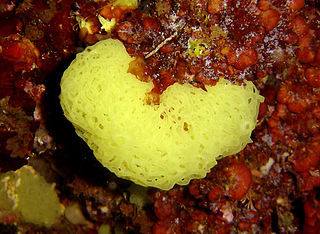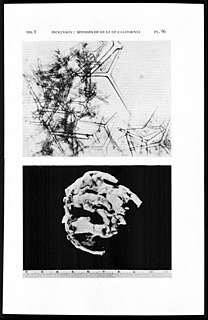| Trichogypsiidae | |
|---|---|
| Scientific classification | |
| Kingdom: | Animalia |
| Phylum: | Porifera |
| Class: | Calcarea |
| Order: | Baerida |
| Family: | Trichogypsiidae Borojevic, Boury-Esnault & Vacelet, 2000 [1] |
Trichogypsiidae is a family of sponges in the class Calcarea.
| Trichogypsiidae | |
|---|---|
| Scientific classification | |
| Kingdom: | Animalia |
| Phylum: | Porifera |
| Class: | Calcarea |
| Order: | Baerida |
| Family: | Trichogypsiidae Borojevic, Boury-Esnault & Vacelet, 2000 [1] |
Trichogypsiidae is a family of sponges in the class Calcarea.

The siliceous sponges form a major group of the phylum Porifera, consisting of classes Demospongiae and Hexactinellida. They are characterized by spicules made out of silicon dioxide, unlike calcareous sponges.

Clathrina is a genus of calcareous sponge in the family Clathrinidae. Several species formerly in Clathrina were transferred to the newly erected genera Arturia, Ernstia, Borojevia, and Brattegardia in 2013. The name is derived from the Latin word "clathratus" meaning "latticed".
Baerida is an order of sea sponges in the subclass of Calcaronea, first described in 2000 by Radovan Borojevic, Nicole Boury-Esnault and Jean Vacelet.
Grantia is a genus of calcareous sponges belonging to the family Grantiidae. Species of the genus Grantia contain spicules and spongin fibers.
Ascaltis pelliculata is a species of sea sponge in the family Leucascidae, first described as Leucoselenia pelliculata by Arthur Dendy in 1891. it is found in the coastal waters of Victoria.
Leucandra is a genus of calcareous sponge belonging to the family Grantiidae. Its earliest known fossils are from the Jurassic.
Leuconia is a genus of calcareous sponges in the family Baeriidae. It was described by English anatomist and zoologist Robert Edmond Grant in 1833.

Sycon is a genus of calcareous sponges belonging to the family Sycettidae. These sponges are small, growing up to 7.5 cm and having length from 2.5 to7.5, and are tube-shaped and often white to cream in colour. They are known to aquarium hobbyists as "Pineapple" or "Q-Tip" sponges, and are frequent "hitchhikers" accidentally brought in.

Arthur Dendy was an English zoologist known for his work on marine sponges and the terrestrial invertebrates of Victoria, Australia, notably including the "living fossil" Peripatus. He was in turn professor of zoology in New Zealand, in South Africa and finally at King's College London. He was a Fellow of the Royal Society.

Arturia is a genus of calcareous sponge in the family Clathrinidae which contains 14 species. It is named after Arthur Dendy, a prominent researcher of calcareous sponges. It was renamed Arturia in 2017 because the name Arthuria was already assigned to a genus of molluscs.
Amphoriscus is a genus of calcareous sponges in the family Amphoriscidae.
Baeriidae is a family of calcareous sponges in the class Calcarea. It was named by Borojevic, Boury-Esnault, and Vacelet in 2000. The type genus is BaeriaMiklucho-Maclay, 1870, by original designation, though Baeria is now considered a junior synonym of LeuconiaGrant, 1833.
Kuarrhaphis is a genus of calcareous sponges in the family Trichogypsiidae. It consists of one species, Kuarrhaphis cretacea.

Soleneiscus is a genus of calcareous sponges in the family Dendyidae.
Jean Vacelet is a French marine biologist who specialises in the underwater fauna of the Mediterranean. After earning his licence at the Faculté des Sciences de Marseille and learning to dive in 1954, he specialised in the study of sponges at the Marine station of Endoume, and there he has stayed faithful to both sponges and place for more than half a century. His research has included all aspects of sponges: taxonomy, habitat, biology, anatomy, their bacterial associations, and their place in the evolution of multi-celled animals. He has studied them not only in the Mediterranean but in the Indian Ocean and the Pacific. Exploration of underwater grottoes, together with Jacques Laborel and Jo Hamelin, revealed the existence of sponges dating from very ancient geological periods and the unexpected existence of carnivorous sponges, and surprisingly, the grottoes in some ways mimicked life at much greater depths.
Gert Wörheide is a German marine biologist who works mainly on marine invertebrates. He earned his doctorate in geobiology from Georg-August-Universität, following this with a post-doctorate at Queensland Museum (1998-2002), where he worked with John Hooper on sponges,a collaboration which continues.
Ascaltis is a genus of sponges in the family Leucascidae, first described in 1872 by Ernst Haeckel.
Ascaltis grisea is a species of sea sponge in the family Leucascidae, first described as Leucosolenia grisea by Arthur Dendy in 1891. It is known only from its type locality on the Houtman Albrolhos archipeligo in Western Australia. It is a marine sessile filter-feeder.
Leucetta villosa is a species of calcareous sponge in the family Leucettidae, and was first described in 1999 by Gert Wörheide and John Hooper. The species epithet, villosa, comes from the Latin, villosus ("hairy"), and was given because of the "hair-like extensions on the sponge surface".

Leucetta is a genus of sponges in the family Leucettidae, which was first described in 1872 by Ernst Haeckel. The type species is Leucetta primigenia Haeckel, 1872 by subsequent designation.
| This article about a calcareous sponge is a stub. You can help Wikipedia by expanding it. |